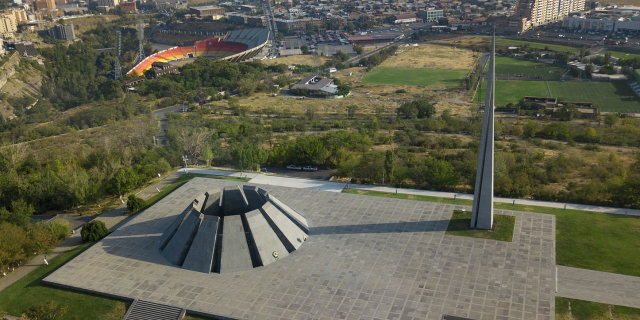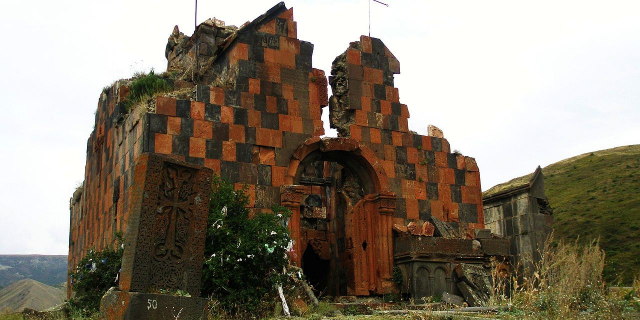The History Museum of Armenia (Armenian: Հայաստանի պատմության թանգարան, romanized: Hayastani patmut'yan t'angaran) is a museum in Armenia with departments of Archaeology, Numismatics, Ethnography, Modern History and Restoration. It has a national collection of 400,000 objects and was founded in 1920. Of the main collection, 35% is made up of archaeology-related items, 8% is made up of ethnography-related items, 45% is made of numismatics-related items, and 12% is made up of documents. It is regarded as Armenia's national museum and is located on Republic Square in Yerevan. The state financially supports the museum and owns both the collection and the building. The museum carries out conservation and restoration work and publishes works on Armenian architecture, archaeology, ethnography, and history. They also have published a series of reports on archaeological exca...Read more
The History Museum of Armenia (Armenian: Հայաստանի պատմության թանգարան, romanized: Hayastani patmut'yan t'angaran) is a museum in Armenia with departments of Archaeology, Numismatics, Ethnography, Modern History and Restoration. It has a national collection of 400,000 objects and was founded in 1920. Of the main collection, 35% is made up of archaeology-related items, 8% is made up of ethnography-related items, 45% is made of numismatics-related items, and 12% is made up of documents. It is regarded as Armenia's national museum and is located on Republic Square in Yerevan. The state financially supports the museum and owns both the collection and the building. The museum carries out conservation and restoration work and publishes works on Armenian architecture, archaeology, ethnography, and history. They also have published a series of reports on archaeological excavations since 1948. The museum carries out educational and scientific programs on Armenian history and culture as well.
 Frontal view of the building at night.
Frontal view of the building at night.On 9 September 1919, the National Assembly of Armenia founded the History Museum of Armenia. The museum opened to visitors on 20 August 1921.[1] Its first director was Yervand Lalayan. Originally named the Ethnographic-Anthropological Museum-Library, it has been renamed several times, first to the State Central Museum of Armenia (1926), then to the Historical Museum (1935), the State History Museum of Armenia (1962), the Cultural-Historical Museum (2000), and finally to the History Museum of Armenia (since 2003). The museum was formed using the collections of the Armenian Ethnographical Association of the Caucasus, the Nor Nakhijevan Museum of Armenian Antiquities, the Museum of Antiquities of Ani, and the Vagharshapat Repository of Ancient Manuscripts. The original collection numbered 15,289 objects.
In 1935, the Central Committee of the Communist Party of Armenia, established separate museums. These museums received items that originally were part of the History Museum of Armenia:
The Museum of Art of the Armenian SSR, was organized according to the History Museum's Department of Art (the current National Gallery of Armenia) and received 1,660 objects. The Museum of Literature, (the current Charents Museum of Literature and Arts) was formed from the History Museum's Department of Literature and received 301 objects and 1,298 manuscripts. The State Museum of Ethnography was founded in 1978 and received 1,428 objects and 584 photographs.The museum continually replenishes its collections with finds from current excavations made at ancient Armenian sites by the Institute of Archaeology and Ethnography and the National Academy of Sciences of Armenia. Other objects are obtained through purchases and donations. The museum represents an integral picture of the history and culture of Armenia, from prehistory to the present day. The museum also presents rare traces of cultural interrelations between ancient eastern societies in the Armenian Highlands. These ancient societies include Caucasus, Crete, Egypt, Mitanni, the Hittite Kingdom, Assyria, Iran, the Seleucid Empire, the Roman Empire, and the Byzantine Empire.
Among its directors were Yervand Lalayan (1919-1927) and Karo Ghafadaryan (1940-1964).




















![[node:title]](/sites/default/files/styles/640x320/public/pla/images/2021-03/Monasterio_Khor_Virap%2C_Armenia%2C_2016-10-01%2C_DD_25.jpeg?h=7c882872&itok=TSlbC6VX)








Add new comment